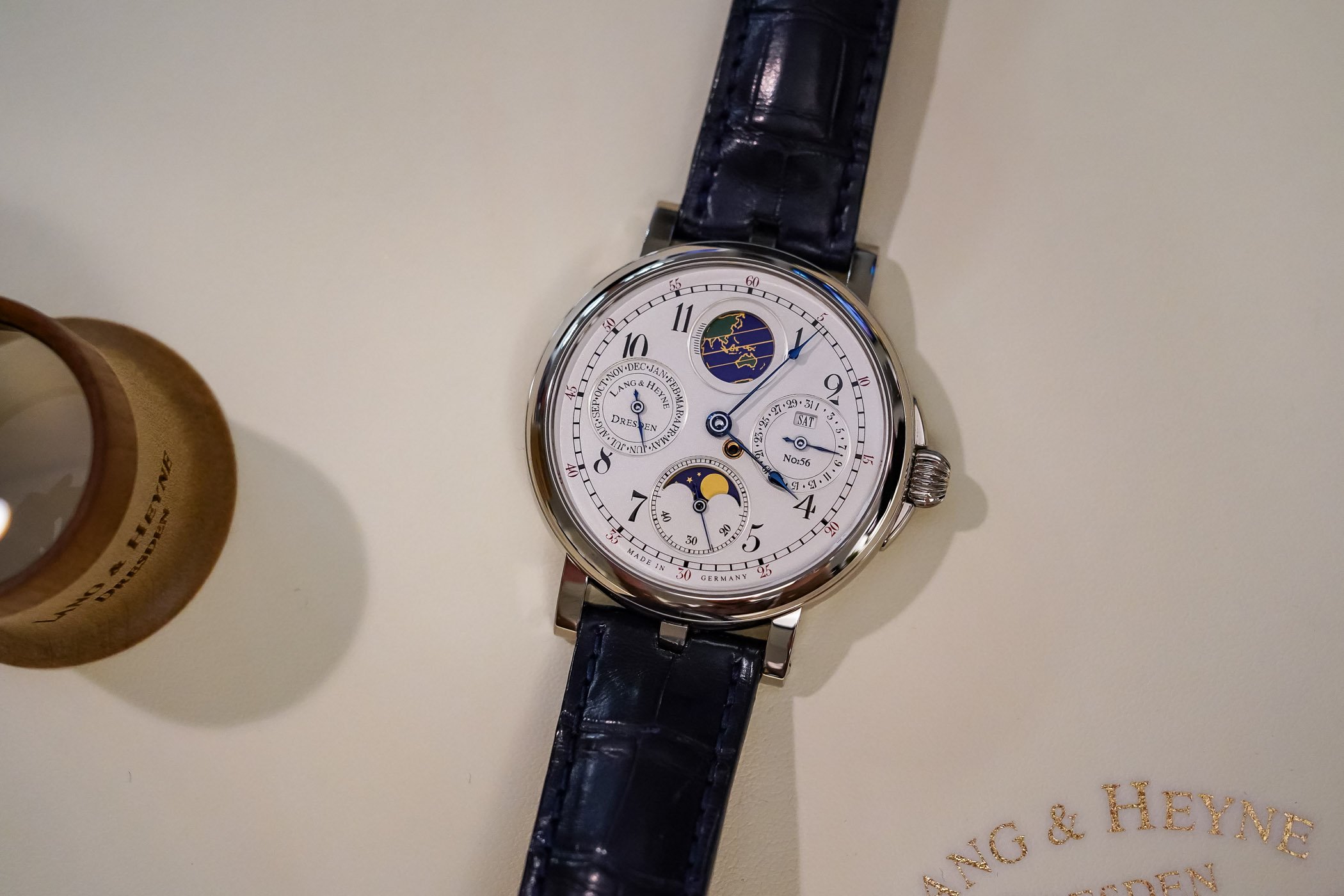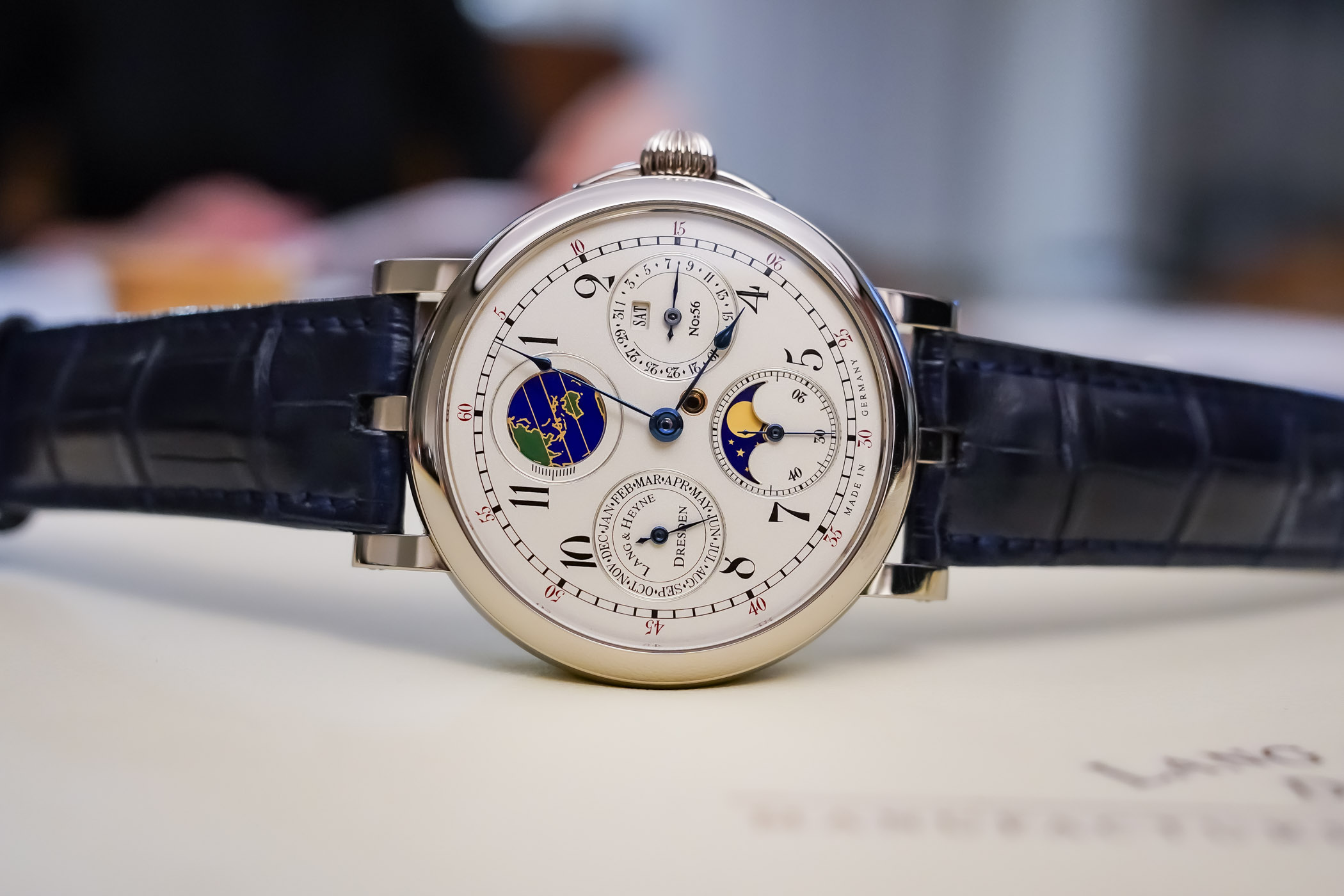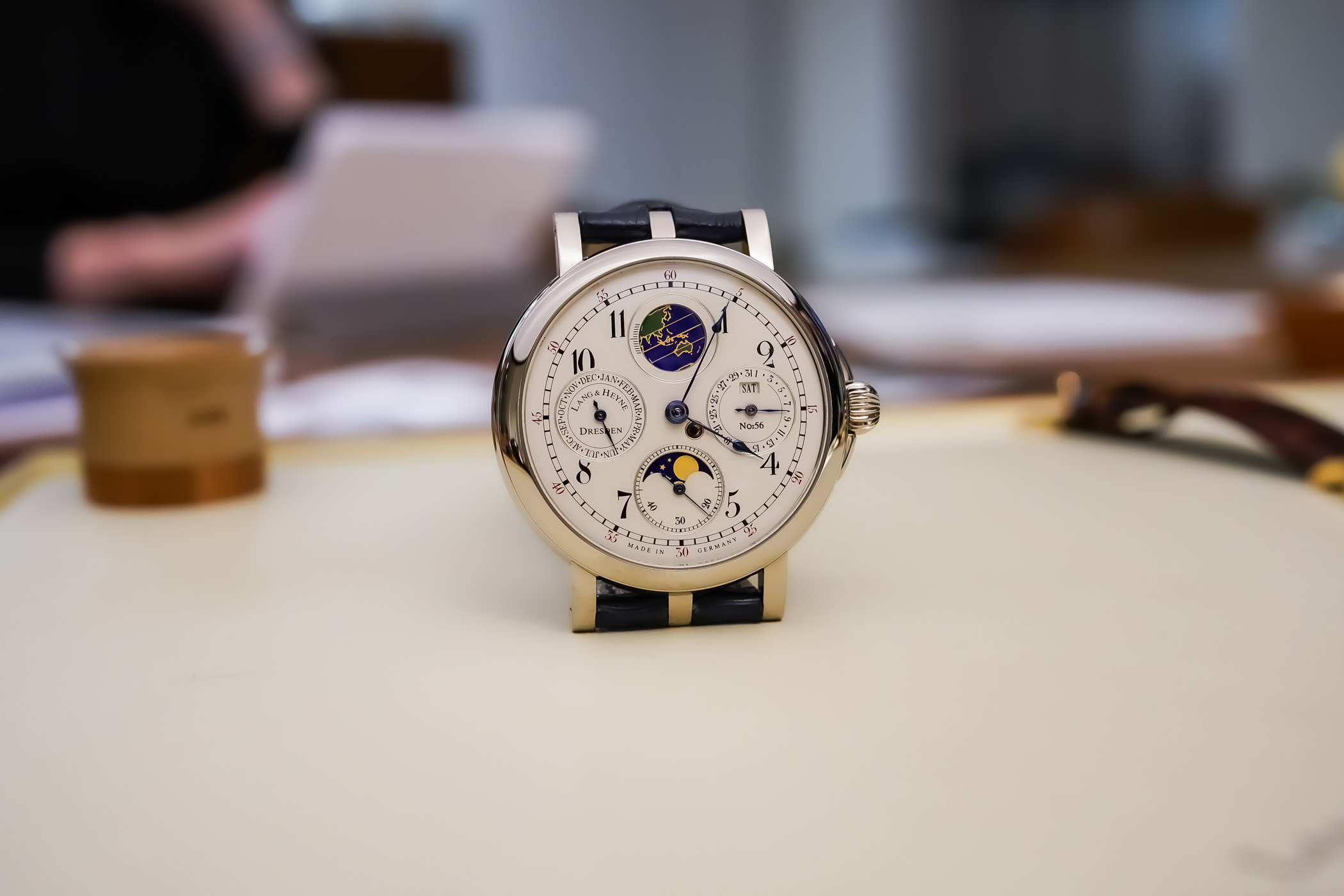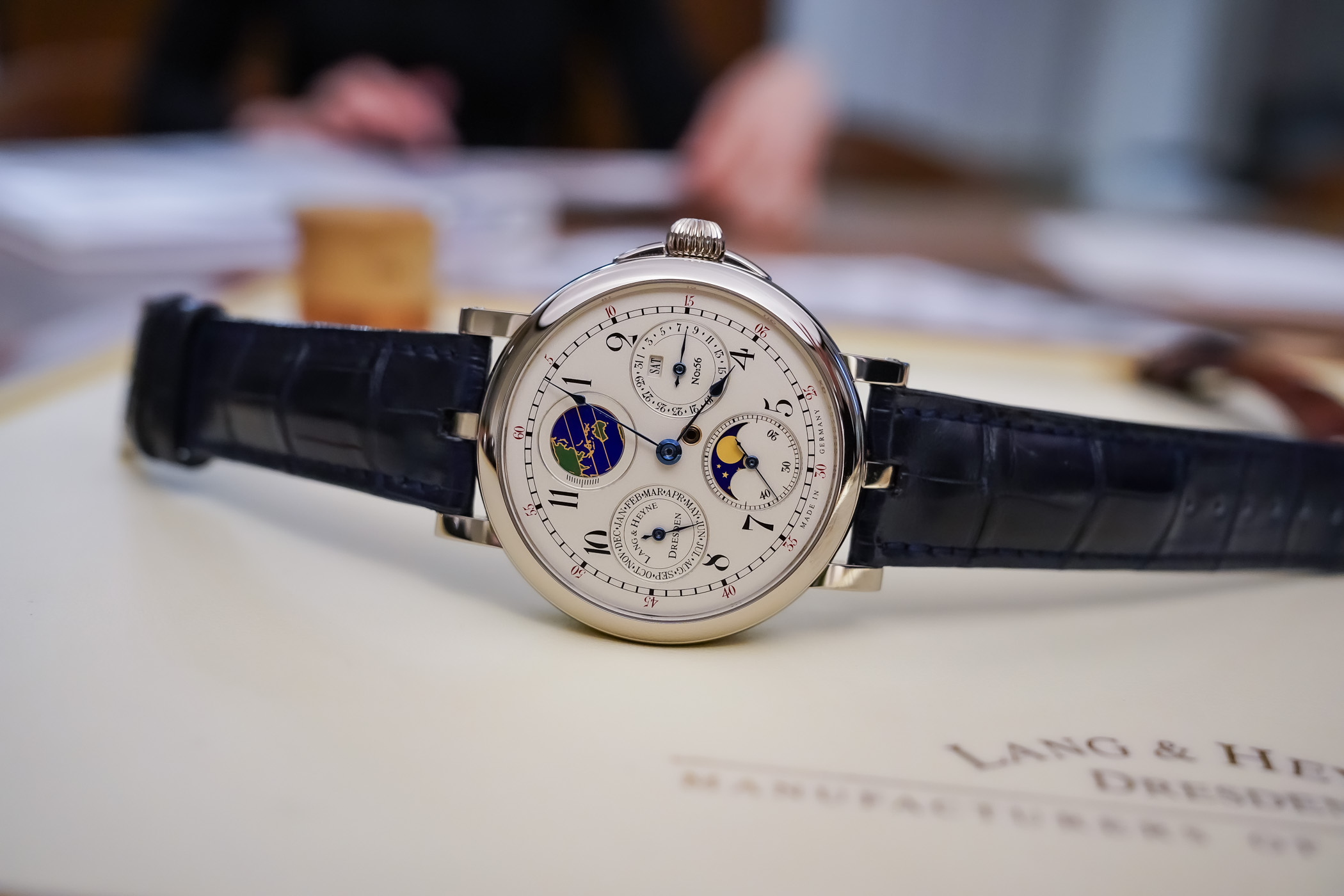The Lang & Heyne Moritz, a Complete Calendar with a Unique Declination Indication
The Earth will tilt with the movement of your wrist.

In the vast realm of heavenly wonders, a timepiece exists tailored for every cosmic inquiry. Whether you yearn to unravel the Earth’s speed at the equator, comprehend its orbital dance around the Sun, or learn the angles at which sunrays caress your corner of the world throughout the year, rest assured. There’s a watch designed precisely for that purpose. Today, let’s explore the captivating Lang & Heyne Moritz full calendar with a declination indication, a horological beauty that recently graced our experience during a visit to the venerable Saxon watchmaker.
Founded in 2001 by watchmakers Marco Lang and Mirko Heyne, Lang & Heyne remains a beacon of German watchmaking excellence despite its founders’ departure to pursue other ventures. The Moritz, introduced over a decade ago during Marco Lang’s tenure, adheres to the brand’s tradition of naming watches after German historical figures. In this case, it pays homage to the elector Moritz (1521-1553), a man of political and military acumen and a profound interest in culture. Ruling Saxony from Dresden, Moritz laid the groundwork for the city’s cultural and political renaissance. Can we envision a modern-day cultured individual wearing this timepiece? Certainly, yes.
Here encased in white gold, the Moritz measures a commanding 44mm in diameter and 12.5mm in height, perhaps a bit too large for some; still, paired with a leather strap, it sits comfortably on the average-sized wrist. The highly polished case, adorned with Lang & Heyne’s distinctive three-lugged design, cradles an onion-like crown protected by guards at 3 o’clock. The watch showcases an elegant, finely blasted solid silver, light champagne-coloured dial with a classical and symmetrical layout. Arabic numerals grace the space, marking the stage with the slender central hour and minute spade-like blued hands gracefully indicating the time. A railway minute track, with numerals in red to mark 5-minute intervals, and the month sub-dial housing the brand’s logo add to the meticulous detailing. The timepiece’s number, which you see printed in the date and day sub-dial opposite, is here in our photos because we handled an earlier Moritz, the serial number is no longer printed on the latest versions.
The main dial hosts traditional calendar complications, featuring recessed sub-dials indicating the analogue date at 3 o’clock, incorporating a small rectangular window for the day of the week. At 6 o’clock, the running seconds’ sub-dial shares the space with a classic moon phase presentation, adding a celestial touch, with the gold champlevé enamelled moon disc accurately portraying the lunar cycle. The month indication is at 9 o’clock, and to complete the “usual” ensemble, take note of the polished gold chaton near the centre and the date-day dial – an elegant day/night indication displaying blue for the nighttime. It’s worth noting that two correctors are positioned on the crown side of the case for moon phase and day-of-the-week settings.
At 12 o’clock, the sub-dial that sets the Lang & Heyne Moritz apart comes into play – the declination indication, a rare, if not unique feature that adds another layer of astronomical sophistication. From those riveting high school astronomy classes, we recall that Earth’s axis isn’t perpendicular but has a tilt of about 23.5 degrees – an axial tilt known as obliquity. This tilt causes varying sunlight angles throughout the year, giving rise to seasons. The Northern Hemisphere experiences summer when tilted toward the Sun, and vice versa for the Southern Hemisphere. While this knowledge is commonplace, having it elegantly represented on a wristwatch is a testament to curiosity and ingenious engineering. The fun part is that the idea came from one of Lang & Heyne’s clients and collectors (a certain Nikolaus Garnreiter from Ulm).
The declination sub-dial features a gold disc, enamelled to represent – in our case – an Earth view from the Asian and Australian viewpoint. Models for Europe & Africa and the Americas also exist and offer diverse perspectives. A graduated scale on the left helps to envision the Sun’s degree to the equator at midday. The Earth disc movements are carefully orchestrated and controlled by a program disc for precise information transmission.
During the Spring and Fall equinoxes on March 21 or September 21, the Earth’s disc equator line aligns precisely with the centre mark of the scale. This alignment signifies that the Earth is angled approximately 90 degrees away from the Sun, resulting in both the Northern and Southern Hemispheres being equally lit. As we near the Summer solstice in June, the disc tilts to its extreme left position, aligning the equator line with the line representing the 23.5 degrees mark. This positioning means the Sun imparts its most direct energy to the Northern Hemisphere. Conversely, the disc inclines to the right in December, when the Sun sends most power to the Southern Hemisphere.
A not-so-obvious feature of the timepiece is the precision with which it rapidly changes the date and the day of the week, precisely at midnight. This aspect beckons us to delve into the inner workings of the Moritz, the movement that breathes life into this exceptional watch, prompting us to flip it over. Secured by eight polished screws, the transparent caseback unveils the Caliber III, a manually wound movement endowed with unique features and fascinating finishing techniques.
Upon quick inspection, connoisseurs will recognise a resemblance between this side of the movement and the Caliber I, the engine that powers the brand’s Johan and Friedrich August time-only watches. Caliber III, an evolution of Caliber I, incorporates necessary modifications to accommodate additional indications. An extra 1.5mm-thick plate manages all the calendar functions, and the winding mechanism underwent re-engineering to facilitate easy adjustments of the date, month, and declination settings via the crown in the third position. Turning the crown moves the date forward or backwards, subsequently adjusting the month, with the Earth’s disc tilting correlated.
The Caliber III keeps the stop-second system for precise hand positioning found in Caliber I (and IV, for that matter) with a lever applying pressure against the balance wheel with a spring, stopping it. The Caliber III also shares the same 18,000 vibrations/hour operating frequency and 46-hour power reserve.
The visible part of Caliber III showcases Lang & Heyne’s mastery, with a three-quarter plate – a distinctive trait of Saxon watchmakers since the late 19th century. The plates and bridges receive a traditional finish reminiscent of the bygone era of Saxon watchmaking, creating a grain-like surface using a fine brush and a mix of silver powder and salt, then plated in gold. Each bearing jewel is embraced by finely countersunk gold chatons, elevating the movement’s aesthetic appeal. Even the tiniest stone, holding the lever anchor, resides in gold chaton secured by blued steel screws. Atop the hand-engraved balance cock featuring an elegant swan-neck fine adjustment, rests the natural diamond that crowns the balance. The snailing on the ratchet wheel is immaculate, and the hand-engraved Lang & Heyne Dresden text and the timepiece’s model number add warmth to this very appealing exemplar of Saxon watchmakers.
As mentioned earlier, the Lang & Heyne Moritz is available with three different Earth disc views. Since its introduction, it has been available in three precious metal cases – rose, platinum and like the watch we experienced, in white gold. The asking price for this 18k white gold edition is USD 56,000, and the brand offers quite a few customisation options and bespoke finishes on order – from hand-engraving to gem-setting. However, seeing how anything can better the already beautiful Moritz is complicated. A classical timepiece with plenty of detail and intelligent engineering, it is worth a royal collection, but it is also quite wearable and even practical. What more to ask? A slightly smaller case, maybe…?
For additional information, please visit lang-und-heyne.de.















